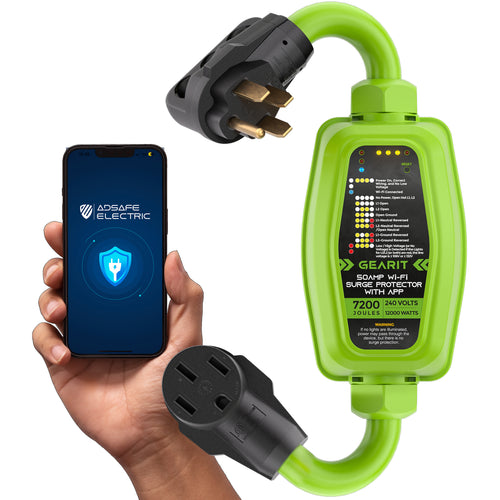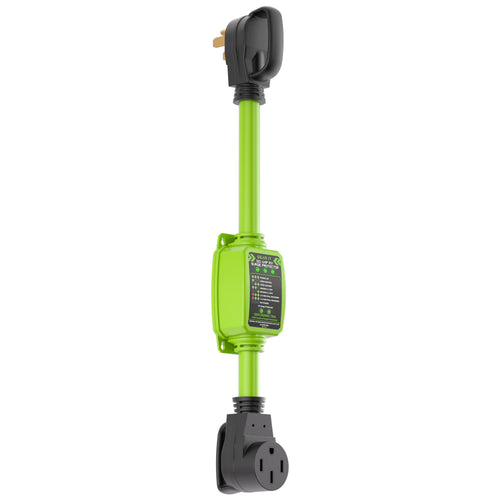The surge protector panel code helps keep your electrical system safe from sudden power surges. Things like lightning strikes or utility spikes can cause serious damage to your home or business, and surge protective devices (SPDs) are there to stop that from happening. The code makes sure your setup is ready to handle these kinds of problems.
In this blog, we’ll break down what the surge protector panel code means, why it’s important, and how you can make sure your system is up to standard. Whether you’re upgrading your home or running a workspace, this guide will help you stay protected and avoid unnecessary hassles.
What Is The Surge Protector Panel Code?
Surge protector panel codes refer to guidelines and rules set by the National Electrical Code (NEC) to ensure homes and buildings are protected against electrical surges.
These codes help guarantee both safety and efficiency by requiring specific types of surge protection devices (SPDs) in various installation points.
Surge protection devices come in three types: Type 1, Type 2, and Type 3.
- Type 1 SPDs are installed at the power utility's feed before the main service panel, offering the first line of defense.
- Type 2 SPDs are fitted after the main breaker, usually inside panels, to safeguard household circuits.
- Type 3 SPDs are located near point-of-use devices and offer localized protection.
What Are The Specific NEC Articles Related To Surge Protection?
The National Electrical Code (NEC) outlines specific rules to protect electrical systems from power surges. Let’s explore key updates and requirements:
2020 NEC Update
Surge protection became a priority in 2020 as power surges became more common due to lightning, grid issues, and modern electronic usage. Here's what this update means:
- What it requires: Surge protection is mandatory for all new or replaced electrical service panels in residential properties.
- Why it matters: Power surges can damage appliances, disrupt electronics, and even pose fire risks. This update ensures residential electrical systems are safeguarded.
- Where it applies: This requirement applies to all dwelling units, including single-family homes and multi-family residences.
Article 230.67 (2023 NEC)
Building on the 2020 update, Article 230.67 provides more detailed requirements for residential surge protection. Here’s what you need to know:
- What it requires: All residential service panels must include surge protective devices (SPDs). The specific type depends on the setup:
- Type 1 SPDs: Installed on the supply side of the main service disconnect, protecting the entire system from surges.
- Type 2 SPDs: Installed on the load side, often integrated into the service panel, providing localized protection.
- Why it matters: This article reduces the risks of surge-related damages to sensitive appliances and electronics, ensuring safer, more reliable electrical systems.
- Where it applies: Covers all new or upgraded residential service panels.
Section 409.70
Surge protection is equally important in industrial environments, where vital systems and expensive equipment are at stake. Section 409.70 sets clear guidelines:
- What it requires: SPDs must be installed near control panels to protect critical circuits and systems in industrial facilities.
- Why it matters: Power surges in industrial settings can lead to significant downtime, costly repairs, or equipment failure. SPDs ensure system reliability and prevent interruptions.
- Where it applies: Applicable to factories, warehouses, and other industrial facilities where control panels manage essential operations.
By following these NEC standards, homeowners and businesses alike can enhance the safety and resilience of their electrical systems, avoiding costly damage and maintaining smooth operations.
Protect your home with reliable surge protection that meets code requirements. Check out our collection of home surge protectors for solutions you can trust.
Why Is the Surge Protector Panel Code Important?

The surge protector panel code goes beyond just meeting regulations—it’s about protecting your electrical system, ensuring safety, and avoiding unnecessary expenses. Here’s why it matters:
Protecting Your Electrical System
Power surges, caused by lightning, grid issues, or equipment malfunctions, can severely damage your electronics and appliances.
Without proper surge protection, critical systems like HVAC units, computers, and kitchen appliances are vulnerable. The code ensures surge protectors are in place to limit these surges, helping you avoid expensive repairs or replacements.
By adhering to these standards, you can keep your systems running efficiently and minimize disruptions.
Improving Safety at Home and Work
Electrical surges don’t just damage devices—they can also create fire hazards. Overloaded circuits caused by surges can spark fires, posing a risk to people and property.
Surge protection requirements in the code are designed to reduce these risks, creating a safer environment for your family, employees, or tenants.
Following these guidelines provides an extra layer of security and peace of mind, knowing your systems are protected from unexpected electrical events.
Staying Compliant and Avoiding Penalties
Surge protector panel codes aren’t just suggestions—they’re required safety rules. Local authorities expect you to follow these codes for new builds, major renovations, or when upgrading your electrical systems. Staying compliant keeps everything up to standard and helps you avoid headaches down the road.
Not following these codes can lead to a bunch of problems, including:
- Failed Inspections: If your system doesn’t meet the code, you might fail inspections, which can hold up your project or delay getting approval to use the space.
- Fines and Legal Trouble: Ignoring the rules could mean fines or, in extreme cases, even legal action.
- Insurance Issues: Without proper surge protection, your insurance might go up—or worse, claims for surge-related damage could be denied.
- Liability for Accidents: If a surge causes a fire or injury and your system isn’t up to code, you could be held responsible.
- Costly Fixes: Systems that fail inspections need to be updated, which means spending extra time and money to fix what wasn’t done right the first time.
On the bright side, staying compliant comes with perks. Many insurance companies offer lower premiums for homes or businesses with surge protection, and having a code-compliant system can boost your property value. Plus, it’s just one less thing to worry about, knowing your electrical setup is safe and up to standard.
Need more power solutions for your setup? Explore our full range of power products designed to keep your electrical system running smoothly and safely.
How To Comply With The Surge Protector Panel Code

To comply with surge protector panel codes, you need the right surge protection device (SPD), proper installation, and awareness of local requirements. Each step helps keep your system safe and up to code.
Choosing the Right SPD
Picking the right SPD is key to protecting your home or building from power surges. Make sure the SPD matches the current and voltage of your electrical setup. For homes, it should handle common surge risks and meet NEC standards.
Look for features like:
- High surge current rating
- Fast response time
- Multiple protection modes
Always choose a certified SPD, especially for places like nursing homes, dorms, or guest rooms. Even limited-care facilities need reliable surge protection.
Installation Guidelines
Installing an SPD correctly is just as important as choosing the right one. It should be placed close to the service panel and installed following manufacturer instructions to ensure safety.
Steps include:
- Turning off power before starting the installation.
- Mounting the SPD securely and connecting it to dedicated circuits.
- Ensuring proper grounding to handle surges effectively.
Hire a licensed electrician to do the job, especially for locations like hotels or patient rooms, where strict safety standards apply.
Checking Local Requirements
Local rules can vary, so it’s important to check your area’s specific regulations. Talk to a licensed electrician or local authorities to understand what’s required.
Consider:
- Local amendments to the NEC.
- Rules for service entrance protection.
- Special requirements for guest suites or sensitive equipment.
In some areas, additional surge protection might be needed for certain circuits. Knowing your local rules helps you avoid violations and ensures long-term safety for your property.
Looking for high-quality cords to complete your system? Browse our selection of electrical cords for durable, reliable connections you can count on.
Conclusion
The surge protector panel code isn’t just about following rules—it’s about keeping your home or workplace safe and protecting your devices from unexpected power surges. Choosing the right SPD, installing it properly, and checking local requirements are all key steps to making sure your system is secure and reliable.
Think about what you need for your setup, whether it’s protecting sensitive electronics or covering a larger system. Investing in good-quality, code-compliant surge protection now can save you money and headaches down the road. If you’re unsure, getting help from a licensed electrician is a smart move to ensure everything is set up correctly.
Want to learn how surge protectors actually work to keep your devices safe? Read more here: How Does a Surge Protector Work?.
Frequently Asked Questions about The Surge Protector Panel Code
Where can I find the best surge protector?
GearIT offers high-quality surge protectors designed to meet your needs, including Type 1 and Type 2 options for different installation points. Look for features like a high joule rating, LED indicators, and strong warranties to ensure reliable protection. With GearIT, you get trusted performance and peace of mind for your electrical system.
What is the code for a surge protection panel?
According to the 2023 National Electrical Code, Article 230.67 mandates surge protective devices (SPDs) for residences. These devices help protect electrical systems from voltage surges, ensuring safety and compliance with current electrical standards.
When did SPD become mandatory?
SPDs became mandatory for residential buildings with the updates to the NEC in 2023. This change ensures that new homes have adequate protection against electrical surges, enhancing safety and reducing the risk of damage to electrical components.
Does every panel need a surge protector?
Not every panel requires a surge protector by itself, but you must comply with NEC requirements, which specify that at least one SPD should be installed in residences. This protects the entire electrical system and any connected devices from power surges.
Where do you put a surge protector on a panel?
Typically, a Type 1 surge protector is installed on the line side before the service panel, often outside. A Type 2 is placed on the load side after the main breaker, inside the panel. They are usually attached to a 240V dedicated circuit breaker within the panel.
Where do you need a surge protector?
Surge protectors are mainly needed at the service entrance of the home or building. They provide a line of defense for all electronic devices and appliances connected to your electrical system. You need to follow NEC guidelines to place them effectively.





















































